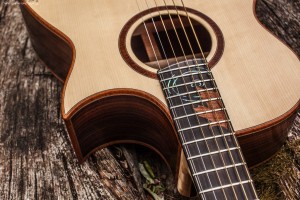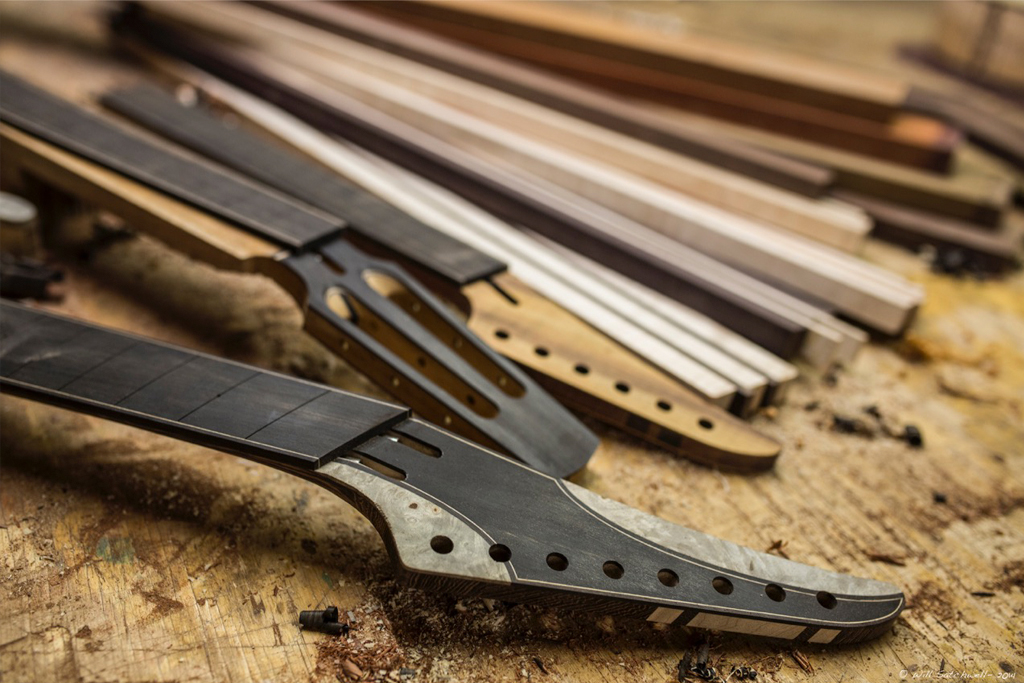Bodies
 All of my acoustic soundboxes are created by hand. I have chosen to abandon side bending jigs and fox bending machines in favor of a simple bending iron as i found the hand bending method far quicker and far more accurate. All of my soundboxes will be voiced according to customer preference, taking into consideration the size of the body and the timbers used. This is a standard procedure and i will liaise with you as to how best to voice your instrument.
All of my acoustic soundboxes are created by hand. I have chosen to abandon side bending jigs and fox bending machines in favor of a simple bending iron as i found the hand bending method far quicker and far more accurate. All of my soundboxes will be voiced according to customer preference, taking into consideration the size of the body and the timbers used. This is a standard procedure and i will liaise with you as to how best to voice your instrument.
With regard to the dressing of the body (ie: binding, rosette, end graft etc) i can either work to your preferences and suggestions or you can leave it ‘open spec’ which allows me creative freedom to design the rosette, end graft and head veneer as i see fit. I have found that my best work is created this way. The choice, however,(as with everything i do) is entirely yours.
Necks, Fingerboards and Headstocks
 Necks are all carved by hand, without exception. I use a 30 year old spokeshave (that i bought second hand at a country wood fair) to carve each and every single neck i produce. I have found that the older the tools, the better they work. I will work closely with you to find exactly what kind of neck shape best suits you and your playing style. Where possible, i will have you visit the workshop once your neck is carved to approve the shape i have created for you. I feel that neck shapes are one of the single most important aspects of building a guitar to get exactly right. I will carve a neck until it feels ‘snug’ in the palm of my hand – once it gets in the correct area of comfort i will put it down and come back a day or two later to finish the carving and cleanup. I have found that having that time away from it really helps keep things clear and precise. Once it is at this stage i will contact you to book a visit (where possible). If you are an overseas customer and visiting isn’t an option that is fine, i will liaise closely with you to produce a neck that is exactly what you want.
Necks are all carved by hand, without exception. I use a 30 year old spokeshave (that i bought second hand at a country wood fair) to carve each and every single neck i produce. I have found that the older the tools, the better they work. I will work closely with you to find exactly what kind of neck shape best suits you and your playing style. Where possible, i will have you visit the workshop once your neck is carved to approve the shape i have created for you. I feel that neck shapes are one of the single most important aspects of building a guitar to get exactly right. I will carve a neck until it feels ‘snug’ in the palm of my hand – once it gets in the correct area of comfort i will put it down and come back a day or two later to finish the carving and cleanup. I have found that having that time away from it really helps keep things clear and precise. Once it is at this stage i will contact you to book a visit (where possible). If you are an overseas customer and visiting isn’t an option that is fine, i will liaise closely with you to produce a neck that is exactly what you want.
Fingerboards are all slotted by hand (using a traditional fret slotting saw) and then bound with (Maple veneer) and Ebony binding. My nut width on my 6 string acoustics is 42mm, and fingerboard width at the 12th fret is 55mm. Neck thickness tends to be 21mm behind the nut and 23mm behind the 12th fret, but this varies from guitar to guitar depending on what i am making. If you order an acoustic specifically for fingerstyle playing the fingerboard width will be 44mm at the nut and 60mm at the body join.
There are three main headstocks that i currently offer on my acoustics. They are simple shapes but they serve my needs and tastes well.
Headstocks tend to be a place where i can have a little fun and get creative – I like to splice timbers together and create head veneers that are a little different from the norm. If this isn’t your thing that is fine – we can keep it simple. If it is something that appeals to you please let me know and we can create something that is personal to you and your instrument.
The reverse faces of headstocks on all of my guitars feature a veneer facing. More often than not this will be an Australian burl. Sometimes it will be a piece of ebony or sometimes it will match the timber of the fingerboard or the back and sides of your guitar. It all depends what will best suit your instrument as to what we use.
Cutaways, Soundports and Arm Bevels
 Alongside all of the regular build options, i do also offer some additional build upgrades. Cutaways can massively improve the playability of an instrument and allow access to notes that were before unplayable – a strong choice for the modern musician. Please note that i only offer Florentine cutaways (pictured).
Alongside all of the regular build options, i do also offer some additional build upgrades. Cutaways can massively improve the playability of an instrument and allow access to notes that were before unplayable – a strong choice for the modern musician. Please note that i only offer Florentine cutaways (pictured).
Things like soundports, and arm bevels may not be that widespread in the mainstream guitar market but can really improve the playability and comfort of a custom build so are always worth consideration when commissioning. all of these options do incur an additional charge to your build, but this is only to cover the large amount of additional time i need to spend on your instrument. Personally, i think it is money well spent.
Extended range
As well as the standard acoustic range i am also currently prototyping some extended range offerings too.
Multiscales are now available on all acoustic models, and i have currently adopted a 25″-26″ fan, with a perpendicular 7th fret. If you would like a multiscale acoustic, but would prefer different scales, please request this in the comments section of the order form you submit.
I am also about to prototype 7 string acoustics (during 2015-2016), so please feel free to get in touch if this is something that may appeal to you.
Finishing
Up until recently i was lacquering all of my own instruments. My father has been in the motor trade for over 40 years and has spent the last 10+ years teaching me how to spray.
Sadly, i have recently had to take the decision that i will be outsourcing all of my clear coating lacquer work from now on purely because i cannot afford to spend so much time on just one stage of a guitars creation. It is not a decision i have taken lightly, but one i have had to make when being realistic with what i am capable of and what kind of throughput i need to produce to stay in business.
As a standard rule your acoustic soundboard will be thinly lacquered with Polyurethane, and the rest of the instrument will be Polyester. This is down to the Polyurethane being far thinner in consistency than the Polyester, thus allowing a far more lightweight finish for the soundboard that allows movement in the way you would want it to. Lacquer thickness is a constant issue when it comes to acoustics and i am very particular about not killing any of the instruments voicing with an over abundance of polyester.
Acoustics can either be finished in gloss or hand rubbed satin.






